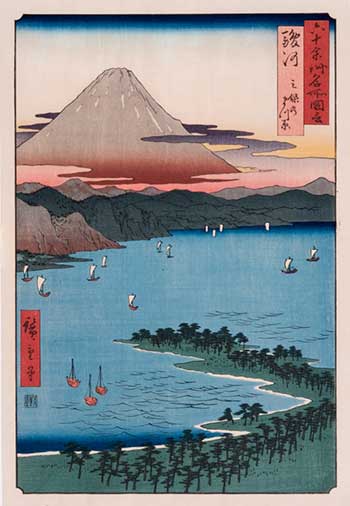Tom on Japan
Japanese Prints – WOW!
 So what’s a guitarist doing writing about Japanese woodblock prints!? Simple—they’re beautiful, fascinating, enigmatic, intriguing, compelling, decorative (if you want), collectible and affordable. For history buffs they provide an inside look at Japan from mighty warriors and great battles—to the everyday lives of peasant, “middle-class” merchant, and courtesan. They are time travel in art, from our century in Japan going back well over 300 years.
So what’s a guitarist doing writing about Japanese woodblock prints!? Simple—they’re beautiful, fascinating, enigmatic, intriguing, compelling, decorative (if you want), collectible and affordable. For history buffs they provide an inside look at Japan from mighty warriors and great battles—to the everyday lives of peasant, “middle-class” merchant, and courtesan. They are time travel in art, from our century in Japan going back well over 300 years.
For lovers of expansive landscapes or seascapes, moonscapes, arching wooden bridges of timeless architecture, flowers and birds, mountains or valleys, majestic volcanos bathed in the red glow of dawn—or a Great Wave towering over hapless boatmen—these prints must be seen to be believed.
One of the great things about Japanese prints is that they can be afforded and collected by far more people than can afford Western art of comparable quality. Most great Western art (we’re talking painting here) consists of uniquely created works which weren’t intended for replication. Anyone fortunate enough to purchase a Renoir owns an original work of art which nobody else can own simultaneously.
Not so Japanese prints, which were intended for replication. And here I need to clarify something. By “replication” I am not talking about art posters mass-produced from a printing press. There is no photo-engraving here. Instead, the print you buy was one of a number manually pressed against a hand-carved block of wood, typically cherry. In many cases the carver’s work required just as much skill as that of the artist who created the original design.
In fact, until modern times in Japan a finished print was really the end product of a team, again very much unlike the Western tradition. The Japanese artist/designer worked with a publisher, who hired expert carvers and printers to complete the job—and then took on the task of marketing the finished prints.
It was the role of the publisher which fundamentally differentiated Japanese print art from its Western counterparts. That’s because at least earlier in Japanese print history it was typically the publisher who came up with ideas for print designs—and hired artists to bring those ideas to fruition. There were exceptions to be sure, but nothing can be more contrary to the Western ideal of the artist as free spirit than this system.
Reprints vs. Originals
You will probably find that often what you are purchasing is a “reprint” (or “re-strike”) rather than an original (variously defined as a print which was pressed onto originally-carved wood blocks during the artist’s lifetime—“lifetime print”—or onto those original blocks after his lifetime (there were very few women print designers). Or sometimes from original, re-carved blocks for special posthumous editions.
“Reprints,” as commonly understood, come from newly carved blocks based on copies of the original design. Because they lack the cachet of original, lifetime prints, and often are produced in far larger quantities than the originals on which they are based, reprints typically sell at a small fraction of what original prints fetch. That’s what makes them so affordable.
Sometimes you can find reprints created with such artistic flair that their quality rivals the original. Those that do tend to sell at a premium price to those that do not.
Price Factors
What determines the price of any particular print? The main factors are rarity (or lack of same) in the market, star power of the artist-designer, print condition (anywhere from terrible to pristine), fineness of detail in the design, market interest in the design, quality of execution in the subject matter, and quality of the impression (made when paper was pressed against the inked wood block to create the finished print). A poor impression may have small breaks in borderlines or inconsistent application of color, to take just two examples.
Learning About Prints
What’s the best way to learn about Japanese prints? Attend special museum exhibitions if available in your area. Read books and online articles about them. But there is a more immediate way of digging into this subject matter—and that’s to locate dealers online, look at photos of their print offerings, and read whatever descriptive or historical and artistic background material they offer along with each print. Some dealers let the prints speak for themselves and provide little written background information, on the assumption that viewers already are familiar with them. Other dealers make no assumptions about your familiarity with Japanese prints and see it as part of their job to help you educate yourself about this art form. By the way, note that many dealers sell online only these days, though there still are walk-in shops in a number of large cities.
One thing is for sure—the more you look the more you will become familiar with the major print artists and their styles. After a while you’ll see a beautiful 19th Century landscape listed on a dealer site, and recognize it immediately as a Hiroshige, or a Hokusai—to name two of the best-known and greatest Japanese print designers.
In our next article on this fascinating subject we’re going to talk about how to buy these prints. We’ll talk about the different types of dealers, and how they work. For those who want to start looking without waiting, we’ve listed some online dealers on the “Helpful Info” page of this website. [NOTE: we have no financial relationship with any firm listed on that page. Businesses are listed for information purposes only as a convenience to our readers.]
© 2014 Tom Silver

